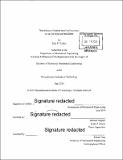| dc.contributor.advisor | Barbara Hughey. | en_US |
| dc.contributor.author | Veldee, Kim E. | en_US |
| dc.contributor.other | Massachusetts Institute of Technology. Department of Mechanical Engineering. | en_US |
| dc.date.accessioned | 2019-12-13T18:57:33Z | |
| dc.date.available | 2019-12-13T18:57:33Z | |
| dc.date.copyright | 2019 | en_US |
| dc.date.issued | 2019 | en_US |
| dc.identifier.uri | https://hdl.handle.net/1721.1/123248 | |
| dc.description | Thesis: S.B., Massachusetts Institute of Technology, Department of Mechanical Engineering, 2019 | en_US |
| dc.description | Cataloged from PDF version of thesis. | en_US |
| dc.description | Includes bibliographical references (pages 68-69). | en_US |
| dc.description.abstract | Typing has become increasingly present in modem lives through its uses in laptops, phones, tablets, and other consumer electronics. Current computers encourage high typing speeds by implementing mistake corrections such as "backspace" or "delete" keys, functions that were previously done by cross-outs or complete rewrites of the entire page. These mistake correction options have minimized the consequences for typing errors and have caused typists to place less importance on typing accuracy. As more models of electronic devices are placed on the market, users build familiarity with and skills for their specific device model. Twelve participants were asked to complete a series of thirty-two typing tests on various laptop keyboards and mobile phones. Measurements were taken of typing speed and accuracy on familiar and unfamiliar keyboards for both laptops and phone keyboards, and specific mistake types were counted and recorded. | en_US |
| dc.description.abstract | The effects of Autocorrection were observed through the transcription of multiple passages with and without Autocorrection enabled. The results were compared between device types (phone vs. laptop keyboards), level of familiarity (personal vs. unfamiliar keyboards), presence of Autocorrection, participant sex, and undergraduate major. Participant sex and undergraduate major did not significantly affect typing speeds on phones or laptop keyboards. Participants typed approximately 20% faster on laptop keyboards than on phone keyboards. Participants decreased in speed when typing on unfamiliar phone and laptop keyboards (approximately 46% slower on phones and 2.7% to 5.5% slower on laptops) and typed about 10% slower when prohibited from utilizing the "backspace" or "delete" keys. | en_US |
| dc.description.abstract | Misspellings were consistently the most frequent mistake type and account for approximately 50% of mistakes, along with bad ordering on laptops (approximately 30%) and incorrectly-located spaces on phones (approximately 20%). Participants who regularly enable Autocorrect typed about 20% slower on phones when Autocorrection was disabled. | en_US |
| dc.description.statementofresponsibility | by Kim E. Veldee. | en_US |
| dc.format.extent | 69 pages | en_US |
| dc.language.iso | eng | en_US |
| dc.publisher | Massachusetts Institute of Technology | en_US |
| dc.rights | MIT theses are protected by copyright. They may be viewed, downloaded, or printed from this source but further reproduction or distribution in any format is prohibited without written permission. | en_US |
| dc.rights.uri | http://dspace.mit.edu/handle/1721.1/7582 | en_US |
| dc.subject | Mechanical Engineering. | en_US |
| dc.title | Dependence of typing speed and accuracy on device type and familiarity | en_US |
| dc.type | Thesis | en_US |
| dc.description.degree | S.B. | en_US |
| dc.contributor.department | Massachusetts Institute of Technology. Department of Mechanical Engineering | en_US |
| dc.identifier.oclc | 1130059783 | en_US |
| dc.description.collection | S.B. Massachusetts Institute of Technology, Department of Mechanical Engineering | en_US |
| dspace.imported | 2019-12-13T18:57:33Z | en_US |
| mit.thesis.degree | Bachelor | en_US |
| mit.thesis.department | MechE | en_US |
